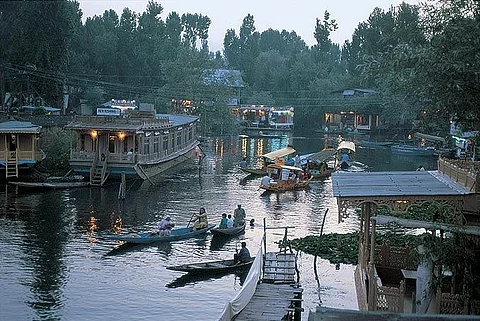
- Destinations
- Experiences
- Stay
- What's new
- Celebrating People
- Responsible Tourism
- CampaignsCampaigns
- Subscribe
- Buy Now

A houseboat On Dal Lake Despite everyone who had any opinion on the subject urging me to experience this marvel, I was sceptical. For a start, it sounded awfully clichéd the kind of been-there, done-that, got-the-T-shirt tourism, which I normally avoid like the plague. And, for another, waterbodies near urban centres in India are generally none too salubrious, and I didn&rsquot fancy trying to sleep with a clothes peg on my nose. But the sunshine had banished the snow, the slopes were muddy, the off-piste action in Gulmarg non-existent, we had two days to kill before our flight &mdash so a houseboat on Dal Lake it was.
There are moments in life when you can actually hear the sound &mdash a sort of long creak followed by a splintering crash &mdash of your preconceptions being overturned. As I stood on the landing stage, gazing out over the waters, it was so loud I was amazed that no one else flinched.
The lake was clear and still as glass. The shikaras &mdash the water ferries that take you from shore to shore and around the lake &mdash glided across silently, as brightly painted as merry-go-round horses.
There are anywhere between 1,000 and 1,500 houseboats on Dal Lake, Nakin Lake and along the Jhelum river. The houseboats do not go floating around across the water (as I had vaguely imagined) but are tethered to the banks, often with their own garden plot behind and a wooden landing stage in front.
The first houseboat was designed and built in 1888 by one Mr M.T. Kenhard. The idea soon caught on. The sumptuously carved interiors, the elegant sit-outs, the peace and beauty of the surroundings, the simply divine climate away from the stifling heat of the plains &mdash all these considerations apart, what really floated the English boat was that it allowed them to build and &lsquosettle&rsquo in a place where they could not own land. I can just imagine them metaphorically thumbing their noses at the judge and saying, &ldquoWell, you never said anything about water...&rdquo
A hundred and twenty years later, the houseboat owners are themselves under threat. The conflict which has raged in Kashmir since the early 1990s has meant that most foreign tourists have stayed away. The outcry over the Amarnath land controversy last year effectively cut short what had been a relatively promising start to the season. And now, justifiable concerns over the environmental degradation of Dal Lake (which has shrunk, according to some calculations, from its original 58 sq km to just 13 sq km) has resulted in the high court issuing the houseboat owners with a stark choice clean up or close down.
But for most houseboat owners, the problem stems not from them, but from the surrounding city. According to the chairman of the Houseboat Owners&rsquo Association, Muhammad Azim Tuman, houseboats are responsible for only about three per cent of the pollution in Dal Lake. Founder of the Royal Group of Houseboats, Rehman Karnai, agrees &ldquoI am 60 years old, and since the last 45 years the whole lake has been so neat and clean. The problem is not primarily with the houseboats it is the encroachments around the lake that are to blame. Small canals that were 100ft wide are now hardly 10ft wide.&rdquo
But as our little troupe glided up to the Crystal Palace, our home for the next few days, these considerations seemed, somehow, very far away. The wide porch jutted out over the water enclosed by an intricately carved portico, whose roof was supported by slender cedar wood poles. The front doors slid open sideways to reveal an interior of carved walnut wood. It was like stepping into a jewellery box. Light filtered through stained glass in multicoloured lozenges. The floor was carpeted in swirls of red and gold. And in the centre of the room, a sturdy iron stove radiated warmth and welcome.
Along the whole length of one side, a narrow corridor, lit by hanging chandeliers, led to the back of the houseboat where our bedroom awaited us thick quilts, hot water bottles and another wood-burning stove scented the air, and banished the chill from our bones. Outside, dusk had fallen, the moon was a thin sliver reflected in the still water and the muezzin&rsquos cries mingled with the calls of the waterbirds as they returned home to roost. The cumulative effect was homely, cosy and magically other-worldly.
I was there in winter, but each season, I imagine, would hold its own particular charm. The cherry and apple blossoms in spring, the sheer bliss of escaping from the heat of the plains in summer, and autumn &mdash the chinar trees ablaze in their sunset colours. Ah Isn&rsquot it true though that the influx of tourists would have a devastating impact on this fragile ecosystem Karnai states the point bluntly &ldquoWe are not civilised yet, that is the problem.&rdquo Houseboat owners clearly feel that the problem is a real one, but that the high court order is misdirected. Can we look forward to a cleaner and clearer Dal Lake &ldquoHopefully,&rdquo he says, diplomatically. &ldquoBut it depends on the people, not just the government agencies. Everyone has their part to play.&rdquo
